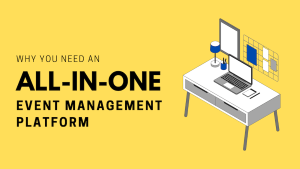
Hybrid events deliver in-person and virtual formats to create interactive experiences for both audiences. Since you can host people locally while encouraging the entire world to attend, this option provides plenty of value to every stakeholder.
The best hybrid events provide high engagement and a broad reach while breaking down geographical barriers. When planned correctly, it’s possible to capture the energy of being together, even if some people are half a world away.
Even as people return to offices and more normal travel routines, the convenience of attending online events heightens the demand to create a hybrid approach.
Although the elements of planning hybrid events are similar to the traditional approach, some distinct differences also exist. That’s why it is crucial to review a thorough checklist when preparing for in-person and online audiences.
Make Hybrid Event Planning More Efficient with this Checklist
A hybrid event combines virtual experiences with in-person opportunities to build interactive and immersive spaces for all attendees. Since this format has unique requirements with its planning, it helps to follow checklists that take you through the various planning stages.
If you’re planning a hybrid event or will be soon, here are the steps to follow to create successful experiences for everyone.
1. Checklist for Planning the Event
Planning a hybrid event requires in-person and virtual options today. In many instances, they must occur simultaneously. Since this stage is the foundation for everything else that happens, the checklist items at this stage have little room for error. []
- Have Defined Objectives and Goals. Prepare the event to meet the attendees’ networking, entertainment, and content needs. There should be opportunities for people to exchange information, have breakout sessions, and have time to talk one-on-one. Online participants could have workshops or group chats with the help of your selected software.
- Keep Things Relaxed. Entertainment doesn’t need to be icebreaker games or bad jokes. You can incorporate several elements into the event, ranging from a group meditation session to a motivational speaker.
- Keep Your Information Relevant.People come to events to learn something. That means the content provided must engage, inspire, and provoke thought. Moderators and speakers create memorable experiences when they address their audiences, including when they are online.
Once you have a framework ready to implement, it helps to have key performance indicators or specific goals set for the event. That allows you to track if your various components reflect the outcomes you hope to achieve.
When you follow these checklist items, you’ll have the cornerstone placed for the foundation of your hybrid event. That’s when you can proceed to the remaining tasks.
2. Checklist for Getting the Agenda Ready
A hybrid event agenda requires a dual perspective. Try to think about it from the view of in-person and online audiences. Each group will need different needs met to have an enjoyable experience, which means the planning phase must recognize those requirements. []
The following checklist items will make it easier to achieve positive results during this stage of the event planning process.
- Understand the Audience’s Needs. Virtual attendees require short, digestible content while requiring more attention for the presenter or moderator. It’s harder to feel like you are part of a group without those structures present. In-person events tend to generate natural excitement, so harness that energy to encourage participation.
- Finalize the Time.When finalizing the event dates and presentation times, it helps to review the relevant time zones for your audience and speakers. Try to pick something convenient that will work for most people – you’ll always have someone a little inconvenienced for a global virtual event.
- Identify the Live Streams.Think about having exclusive sessions for your virtual attendees. If you plan to live stream the event, consider adding filler content or sessions for those in the online audience to ensure they stay engaged. It’s easier to walk away from a presentation when you’re at home.
An agenda shouldn’t be complicated when planning a hybrid event. It just needs to be accurate. When people can set an itinerary for themselves around what to expect, they’ll get to the events that hold the most value for them.
3. Checklist for Determining the Location
Hybrid events automatically have two locations to manage: in-person and online. You’ll need to find a compatible platform that lets you host the virtual component while facilitating activities at both. []
The best platforms have the features and capabilities to support how your online and offline activities work together. Several options are available to use, so the choice depends on finding the one that maximizes the interaction possibilities for attendees.
Here are the checklist elements you’ll want to consider when finalizing your plans for the event.
| Required Capabilities for Online Components | Must-Haves for In-Person Hybrid Venues |
| There must be online event ticketing or registration support to help attendees plan their itineraries. | Large spaces should be available to ensure social distancing rules are still implementable when necessary. |
| An optimized event app makes it easier for the in-person audience to connect with the virtual one. | The facilities must support a hybrid setup for the event. |
| Content management, including live session streaming, chat sessions, Q&As, and an event feed, create a sense of togetherness for all attendees. | Enhanced audio-video equipment is required, including online live streaming capabilities and projector screens. |
| Gamification for the hybrid event should include leaderboards and contests to maintain a person’s attention. | A reliable Wi-Fi connection with appropriate bandwidth ensures all attendees can access online resources. |
| Virtual booths and branding opportunities create an online option for people to explore and mingle. | Multiple charging stations should be available to accommodate the power needs of individual attendee mobile devices and laptops. |
| Badge scanning capabilities ensure that onsite attendee data gets appropriately collected. | Any private rooms with the venue should have the technological support needed to manage hybrid breakout sessions. |
| Lead retrieval and classification, along with advanced real-time analytics, ensure follow-up opportunities get recognized. | Kiosks or tables that host one-on-one and group hybrid meetings facilitate more conversations. |
4. Checklist for Marketing a Hybrid Event
When no one markets a hybrid event, the total number of attendees could be zero. It’s happened. You need to get the word out that you’re hosting something that in-person and online attendees will find valuable.
It might be tempting to jump right into the marketing because you’re so excited about everything else. Still, it helps to have a formal checklist to follow that considers the needs of an audience before, during, and after the hybrid event. []
- Build a Website to Generate Traffic. When you launch a website for the event, make sure that you have an informative landing page that includes an opportunity to register.
- Get Profiles on Social Media Channels.Promote the event on your preferred platforms, including Facebook, Twitter, Instagram, and LinkedIn. If your audience is on Pinterest, your hybrid event information should be findable there. It helps to select a hashtag that you can search periodically.
- Start Email Marketing.You can use this option to send invites, offer promotions, and deliver reminders about the hybrid event. It is also helpful as a tool during the event to let people remember what sessions or activities they want to attend.
- Post Information About the Event.When everything is happening, post about it on social media. Encourage the audience to do the same! You can also use this checklist item to connect virtual and in-person groups. After everything is over, send out a recap of all the content to all attendees, including any valuable takeaways.
If the budget for your hybrid event allows, consider sending swag kits to in-person and virtual attendees before the date of the activities. Encourage everyone to share their items on social media, incentivizing this activity with additional prizes to get more exposure.
5. Checklist for Managing Networking Opportunities
Hybrid events aim to have the online and offline audiences interact with each other throughout the experience. This process requires some planning and foresight to ensure smooth interactions occur. []
There must be an event engagement strategy in place to create successful outcomes in this checklist category for hybrid events. Although every situation is a little different, here are the steps you can take to produce positive results.
- Bring in a dedicated moderator or emcee who interacts with online attendees while being present at the in-person event. Taking this step ensures the virtual audience receives regular updates, check-ins, and announcements.
- Invest in high-quality production services to maximize your online streaming investments, ensuring that immersive experiences are possible.
- Incorporate speed networking sessions into your hybrid events to encourage conversations between the online and offline audiences.
- Use an event app to bring all attendees together on a single platform for a more engaging experience.
Artificial Intelligence (AI) matchmaking technology can suggest names to exhibitors and attendees for additional interactions.
Additional networking opportunities for hybrid events can come from live polls that happen simultaneously online and in-person and question-and-answer sessions with live streaming.
6. Checklist for Reviewing Success
Once the hybrid event is over, start looking at the feedback attendees provide to see how well it performed. The metrics and analytics help you understand the good and the bad of each session, making it easier to know what the audience’s needs are for future activities.
Hybrid event platforms can track specific data points to make it easier to analyze the information. You can also feed the info into a CRM platform to create future targeted marketing campaigns. []
Although a single hybrid event can generate thousands of potential data points, here are some of the top things you’ll want to look for when reviewing this checklist section.
- Session and Speaker Analytics. What ratings did attendees give each session and speaker at the hybrid event? Was there a significant difference between the online and offline audiences? You can also look at the number of session views, total replay count, and social media reactions to specific content.
- Exhibitor and Sponsor Analytics.What booths were the most popular during the hybrid event? How did the visitor count change when comparing in-person and virtual attendees?
- Create Surveys to Get Feedback.It helps to have all attendees fill out surveys during and after the event so that you can receive specific feedback about what works and what doesn’t for each person. Were there activities that could have been better? Was one speaker better than all the others? Once you have this information, it’s easier to structure future sessions to meet these needs better.
You can also look at different engagement and networking analytics to measure the success of hybrid events. From total traffic counts to the number of leads generated, you can see what helped people stay engaged.
It’s Time to Get Started on your Hybrid Event!
When one hybrid event ends, it’s time to start thinking about the next one. That process begins when you send out thank you notes to the various sponsors, speakers, and partners that helped you create a successful experience for attendees.
It helps to share data and provide recordings that demonstrate the event’s success for each presenter, moderator, and sponsor.
After a hybrid event, you can nurture the audience to continue building a community. Start by providing recordings and recaps to online and offline attendees. Highlight the combined nature of the sessions while expressing gratitude for attendance and participation. Even though people attend to generate leads and networking opportunities, it also helps to recognize that they may have gone out of their way to participate in what you planned.
That brings you to the final step. Once you have event recordings and other content available, start repurposing the material into additional marketing options. You can create blog posts, podcasts, or audiobooks to push the hybrid event’s branding while shaping your organic and paid investments.
From SEO to gated content, your current material can keep your hybrid event at the top of the mind for all attendees.
Every hybrid event is a little different, but they all follow a checklist process like the one outlined above. When you start with this structure, you’ll find that it is much easier to create a successful experience for everyone involved.





